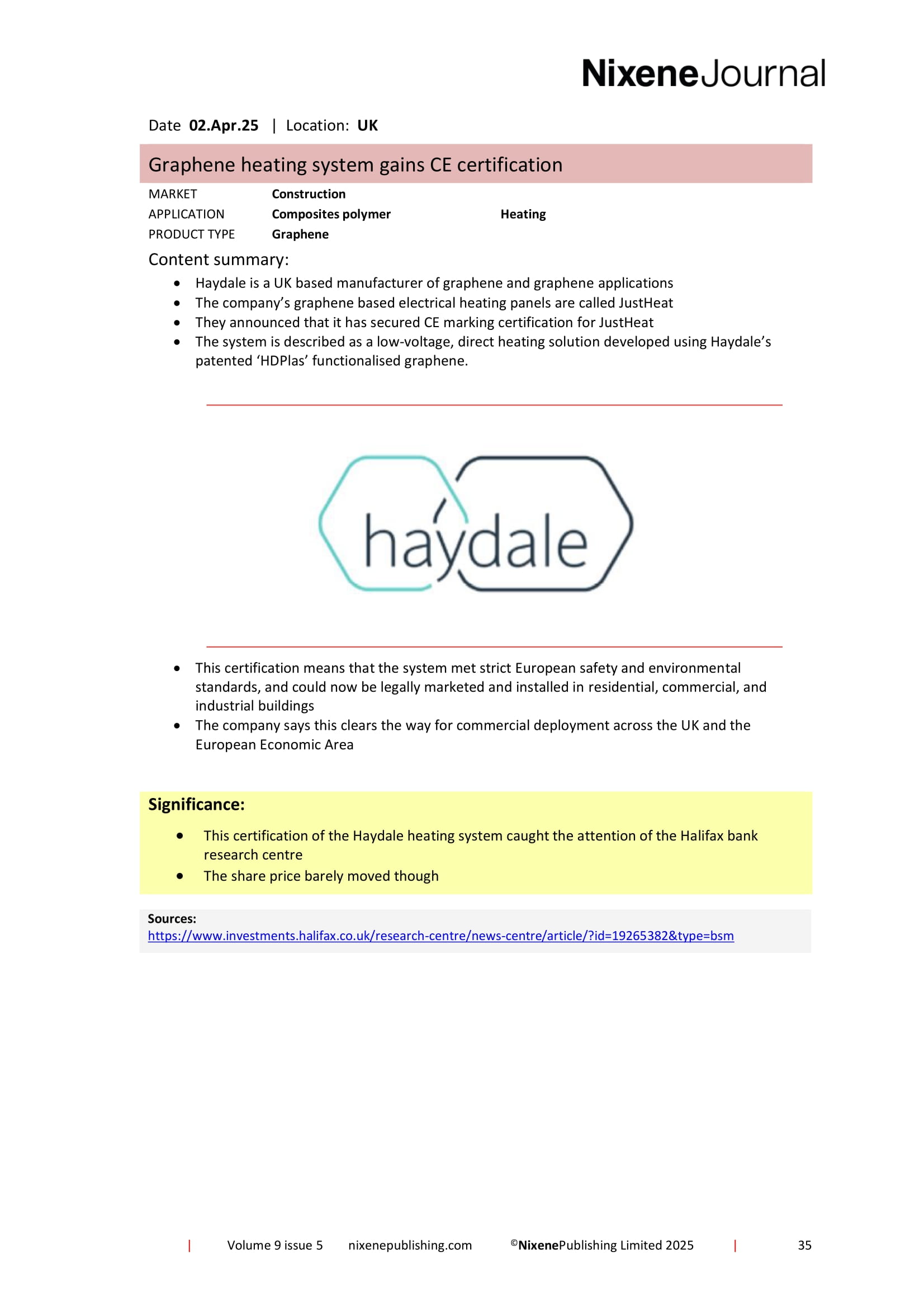Journals
This product is relevant to the following:
Material:
Other:
, ,Locations:
Markets:
Applications:
Product Types:
Technologies:
Related products
-

Vol 6 Issue 6
A sustainable economy is a major aspiration for governments and corporations alike. As we head into the future recycling and upcycling of materials is a major part of this. In principle, plastics should be relatively straightforward to recycle. In practise this is quite challenging because different types of plastics are often bonded together, to achieve different performance criteria, and often end up in waste dumps at the end of the product’s life because these bonded composites are often impossible to recycle. The Ford Motor Company has been making progress addressing this challenge with Prof James Tour’s team at Rice University in the USA. A few days ago, they published the results of their joint work (p.14). They have proved that a variety of waste plastics from end-of-life vehicles can be made into flash graphene powder. The flash graphene was used to make new graphene enhanced polymers which had better mechanical performance, so this can be considered as a prime example of upcycling rather than recycling, (upcycling is the process of converting a material into a new resource of higher quality, value and increased functionality). Ford and Rice are creating an important chapter in the graphene story with this work. Two new two-dimensional (2D) materials have been created for the first time this month. In 2012, a new 2D allotrope (a new form) of carbon called graphyne was thought to be possible to make and some of its properties were predicted. A decade later, a team of chemists at the University of Colorado has actually made small amounts of the material for the first time (p.15). The other new 2D materials are called transition metal carbo-chalcogenides, more easily termed TMCCs. These have been made by a joint team in the USA and Sweden. TMCCs have a combination of electrical conductivity and stability that make them attractive candidates for electronics and energy storage applications. The manufacturing process is also relatively straightforward and scaleable in comparison with similar materials and this could make them a viable commercial proposition in the future. Returning to the sustainability theme; this month, UK graphene manufacturer Levidian Nanosystems Ltd. announced a £700 million deal with the United Arab Emirates (UAE) to supply 500 of its graphene production units. This will capture half a million tonnes of CO2 equivalents (CO2e) over the next five years. The system works by turning methane gas into graphene. The graphene is almost a by-product in this case. The most logical use will be to further reduce CO2 emissions by using the graphene to enhance concrete for many construction projects in the UAE. Graphene is certainly making an impact right where it is needed most – furthering the sustainability agenda, you can find out more by reading on… Adrian Nixon 1st June 2022£45.00 View product -

Vol 6 Issue 10
Dear reader, you will know that we are tracking the progress of the biggest graphene companies in the world. Levidian is the biggest on paper with their announced £700 million ($780 m USD) contract with the UAE (vol 6 iss 6 p.26). The other company is Skeleton Technologies who make graphene enhanced supercapacitors for transport systems. They have been making steady progress over the past few years and have now announced a new €220 million ($215 m USD) super factory that will open in Germany in 2024. This will give the company an order of magnitude increase in production capacity (p.32 of this issue). Skeleton have also announced they have been awarded the contract to supply supercapacitors for the latest metro units in the Spanish city of Grenada (p.22). Further industrial progress is being made in the USA. Cardea Bio is a manufacturer of graphene field effect transistor biosensors. Essentially these are lab-on-a-chip devices that will give an instant read out of medical conditions from a sample of body fluids. The company has mastered the art of mass production and its factories can produce up to 20,000 graphene sensors per month. They also report that next year they will have produced their millionth biosensor. This company is shaping up to be a formidable presence in the graphene biosensor market. On the research and technical side, there has been much progress in the quality control of graphene. Terrance Barkan convened a webinar of metrology experts from world class institutions in the UK, USA and South America. The Raman spectroscopy masterclass is well worth viewing if you need to understand how the quality of graphene is measured by this technique and its limitations (p.15). By coincidence this month researchers in India have developed a new technique for reliably measuring the number of layers of graphene in a sample. Rather than use an expensive raman spectrometer, they have found a much cheaper optical microscope can provide similar information (p.17). In the UK, researchers have published a literature review of sustainable fibres for polymer composites. The work clearly shows why sustainable natural fibres are not being adopted to replace synthetic fibres. Natural fibres are an order of magnitude weaker than their synthetic counterparts. There is room for optimism though. The study shows that graphene can enhance the strength of natural fibres in polymer composites and shows there is one primary candidate natural fibre that, with graphene, just might challenge the supremacy of synthetic fibres (p.18). You can find out about this and much more in this fascinating issue. Dear reader, I invite you to read on… Adrian Nixon 1st October 2022£45.00 View product -

Vol 5 Issue 10
This month, five years ago, we created the first issue of this journal. Since then, we have created a fresh issue every month. Each has unique content. The pace of change in the world of graphene and 2D materials has not let up, if anything the pace is accelerating. This month, graphene nanoplate powders have been used in more commercial applications. Graphene enhanced concrete continues to make the news. Nationwide Engineering and the GEIC have been busy. The foundations for a significant residential development in the UK have been laid with Concretene. A parking bay next to the GEIC building in Manchester UK has also been laid and is the first external structure laid with graphene enhanced concrete and no reinforcing material. Clear story headlines are emerging about graphene enhanced concrete; Concretene • 30% reduction in CO2 emissions • 20% reduction in overall costs Graphene powders have been used to make heat spreaders for electronics. A high-end gaming smart phone and fast access SSD device has appeared on the market this month. Normal heat spreaders are too big for compact device designs, and this is where graphene has a unique advantage because it can create thin and thermally conducting components. Still with graphene nanoplate, a team in Australia has made a pressure sensor for shoe soles. The graphene creates an electrical signal from the pressure created by the wearer. This transmits a signal to a cloud-based AI that analyses the patterns in the data and can warn of conditions such as dementia and diabetes. This being our 5th Anniversary edition we have two special features on CVD graphene. The first examines the state of the art of CVD graphene manufacturing and explores the production cost trend. And finally, we have another special feature (p.9). We normally analyse research papers and condense them down to one page. This time we have created an academic quality paper that shows where CVD graphene manufacturing could be headed. We make the case for multi-layer large-area single crystal graphene. Current thinking is that this material is just graphite. We propose that this material is something entirely new and could even be the foundation for a whole new industrial revolution. Adrian Nixon, 1st October 2021£45.00 View product -

Vol 6 Issue 5
Over the past five years, we have been paying attention to how graphene can improve battery technology. The market focus has been on batteries for electric vehicles. Graphene has been used in the electrodes, and this has made improvements in charging time and battery life. However, energy density has not been improved. Energy density is the amount of energy that can be squeezed into a given volume or mass. This is important for electric vehicles because the higher the energy density, the further a vehicle can travel for a given quantity of batteries. MIT have been paying attention to this battery development dynamic. A spin out company from the university called PolyJoule has developed a new battery (p. 21). This has even poorer energy density, one fifth that of lithium-ion technology, so this is not going to be used for electric vehicles. The MIT researchers have spotted another market – grid storage. These new batteries appear to be ideal for grid storage applications. They charge and discharge rapidly have a long battery life, do not require cooling, and do not need lithium and toxic heavy metals. These batteries are a new intermediate-type between lithium ion and lead-acid technology. We will pay closer attention to this company in the future because storing electricity from renewables such as wind and solar power requires effective grid storage batteries. Also in this issue, Debbie interviewed the CEO of Ceylon Graphene Technologies. This company has local access to some of the highest quality graphite in the world and is very well equipped to process and develop this into high quality graphene powders (p. 7). The company is actively working on new products and extending the value chain towards the market applications. It will be fascinating to see the results of this activity in the market in the coming years. Yet more fascinating research is being published. You may recall that Debbie met Chris Griggs and Sarah Grace Zetterholm of the US Army ERDC (Vol 5 iss 12, p.10). Their team has developed a graphene filter that removes the toxin produced by algal blooms. This filter cleans up poisoned water that is harmful to humans and fish(p.13) Staying with the biology theme, researchers in the Netherlands have developed a graphene sensor that can listen to the sounds made by individual bacteria. This sensor could find uses exploring the effectiveness of antibiotics with unprecedented precision. Another team in the Netherlands has been developing graphene sensors for testing in space. SpaceX launched these sensors this month. The sensors are now approaching a sun synchronous orbit where their performance will be evaluated. Graphene really is out of this world, and as usual there is so much more to read in this issue. Adrian Nixon, 1st May 2022£45.00 View product



